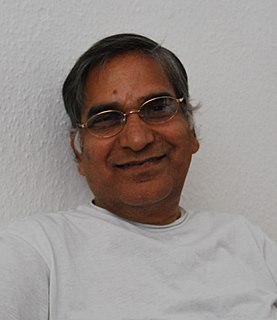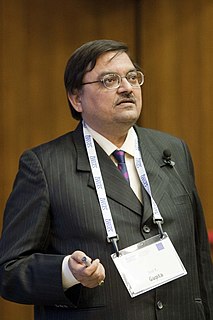This article relies largely or entirely on a single source .(January 2020) |
The Krishnan Medal is an Indian geology award given annually by the Indian Geophysical Union. [1] The award is named after M. S. Krishnan, an eminent geologist.
This article relies largely or entirely on a single source .(January 2020) |
The Krishnan Medal is an Indian geology award given annually by the Indian Geophysical Union. [1] The award is named after M. S. Krishnan, an eminent geologist.
The Indian Geophysical Union instituted the Krishnan Medal to be awarded each year to an outstanding geophysicist/geologist whose age does not exceed 40 years (on 1 January of the year) for outstanding work in specific branches of geophysics/geology and related geosciences.
Nominations each year are called from the members of the Executive Council, past recipients of the medal and past Presidents for the award of the Krishnan Medal and constitute an Expert Committee to make the selection for each year. The medallist is presented with the award at the next annual meeting. Since 1993 a Gold Medal has been awarded to the recipient.
Nominations, along with the bio-data, accompanied by 4 copies of the reprints of 3 important publications of the candidates should be sent to the Secretary, Indian Geophysical Union, by 31 July, of the year.
Source: IGU
The Filmfare Award for Best Story is given by Filmfare as part of its annual Filmfare Awards for Hindi films, to recognise a writer who wrote a film's story.

Sangeet Natak Akademi Puraskar is an award given by the Sangeet Natak Akademi, India's National Academy of Music, Dance & Drama. It is the highest Indian recognition given to people in the field of performing arts. The award earlier in 2003, consisted of Rs. 50,000, a citation, an angavastram, and a tamrapatra. Since 2009 cash prize has been increased to ₹1,00,000. The awards are given in the categories of music, dance, theatre, other traditional arts and puppetry, and for contribution/scholarship in performing arts.

Maharajapuram Seetharaman Krishnan was an Indian Geologist. He was the first Indian to serve as the Director of the Geological Survey of India.

Behara Seshadri Daya Sagar also known as B. S. Daya Sagar is an Indian mathematical geoscientist specializing in mathematical morphology. He is a professor of computer science at the Indian Statistical Institute, Bangalore. He is known as a specialist in mathematical morphology, fractal geometry. chaos theory, and their applications in geophysics, geographical information science, and computational geography. The Indian Geophysical Union awarded him the Krishnan Medal in 2002. He is the first Asian to receive the Georges Matheron Lectureship in 2011. In 2018, he received the IAMG Certificate of Appreciation by the International Association for Mathematical Geosciences for his work on the Handbook of Mathematical Geosciences. In 2020, Sagar was selected as an IEEE Distinguished Lecturer (DL) to represent the IEEE Geoscience and Remote Sensing Society.

Harsh Kumar Gupta is an Indian earth scientist and seismologist, known for his pioneering work on estimation of reservoir-induced earthquakes. He is a former vice chancellor of the Cochin University of Science and Technology (CUSAT) and a Raja Ramanna Fellow at the National Geophysical Research Institute (NGRI), Hyderabad. A recipient of the 1983 Shanti Swarup Bhatnagar Prize for Science and Technology, the highest Indian award in the science and technology category, and the 2008 Waldo E. Smith Award, Gupta was awarded the fourth highest Indian civilian honour of the Padma Shri in 2006.

Mrinal Kanti Sen, an Indian-American geophysicist is the John A. and Katherine G. Jackson Chair in Applied Seismology at the Jackson School of Geosciences of the University of Texas at Austin. He holds joint appointment with the Institute for Geophysics (UTIG) and the Department of Geological sciences (DGS). Since 2016, he has been serving as the head of the energy research division at UTIG. He has been a pioneer in the field Seismic Wave Propagation and Inverse Theory applied to Geophysical Problems. He has published more than 180 papers, and two books, and supervised over 50 graduate students. As an author, he is widely held in libraries worldwide. He was recognized by the Society of Exploration Geophysicists in 2015 for pioneering development and application of global optimization methods in geophysical inversion.
Krishan Lal Kaila (1932–2003) was an Indian geophysicist and seismologist. Born in Lahore of the British India on 7 September 1932, he was known for his studies on deep seismic soundings (DSS) and was one of the pioneers of the DSS technique in India. His studies covered the tectonic regions of Kadapa, Dharwar Craton, Deccan Traps, and the sedimentary basins of Gujarat and the Himalayas and added to the understanding of the geophysics of the region. His researches have been documented as several peer-reviewed articles; ResearchGate, an online article repository has listed 117 of them. Several authors have cited his works in their work.
Vinod Kumar Gaur is an Indian seismologist,a former director of the National Geophysical Research Institute and an honorary emeritus scientist at CSIR Fourth Paradigm Institute, known for his prediction of the April 2015 Nepal earthquake. He is reported to have conducted extensive studies on the tectonics of the Himalayas and is an elected fellow of the National Academy of Sciences, India, The World Academy of Sciences, Indian Academy of Sciences and the Indian National Science Academy. The Council of Scientific and Industrial Research, the apex agency of the Government of India for scientific research, awarded him the Shanti Swarup Bhatnagar Prize for Science and Technology, one of the highest Indian science awards for his contributions to Earth, Atmosphere, Ocean and Planetary Sciences in 1979.
Kunchithapadam Gopalan is an Indian geochronologist and an emeritus scientist at National Geophysical Research Institute. He is known for his studies on the chronologies of critical rock suites of the Indian subcontinent and is an elected fellow of the Indian Academy of Sciences, Indian National Science Academy, Indian Geophysical Union and the National Academy of Sciences, India. The Council of Scientific and Industrial Research, the apex agency of the Government of India for scientific research, awarded him the Shanti Swarup Bhatnagar Prize for Science and Technology, one of the highest Indian science awards for his contributions to earth, atmosphere, ocean and planetary sciences in 1982.
Sethunathasarma Krishnaswami (1945–2015), popularly known as Swami, was an Indian geochemist and an honorary scientist at the geosciences division of the Physical Research Laboratory. He was known for his studies on low temperature geochemistry and was an elected fellow of the Indian Academy of Sciences, Indian National Science Academy, The World Academy of Sciences, National Academy of Sciences, India, American Geophysical Union, Geochemical Society and European Association of Geochemistry (2003). The Council of Scientific and Industrial Research, the apex agency of the Government of India for scientific research, awarded him the Shanti Swarup Bhatnagar Prize for Science and Technology, one of the highest Indian science awards for his contributions to Earth, atmosphere, ocean and planetary Sciences in 1984.

Sri Niwas (1946–2012) was an Indian geophysicist and a professor at the Department of Earth Sciences of the Indian Institute of Technology, Roorkee. He was known for his researches on the Inversion of Geophysical Data. He was an elected fellow of all the three major Indian science academies viz. Indian National Science Academy, Indian Academy of Sciences, National Academy of Sciences, India as well as Indian Geophysical Union and was an elected member of the Association of Exploration Geophysicists. The Council of Scientific and Industrial Research, the apex agency of the Government of India for scientific research, awarded him the Shanti Swarup Bhatnagar Prize for Science and Technology, one of the highest Indian science awards for his contributions to Earth, Atmosphere, Ocean and Planetary Sciences in 1991.
Shyam Sundar Rai is an Indian seismologist and a former chair professor at the department of Earth and Climate Science of the Indian Institute of Science Education and Research, Pune. He is known for his researches on the seismic structure of Indian continental lithosphere and is an elected fellow of all the three major Indian science academies viz. Indian National Science Academy, Indian Academy of Sciences, and the National Academy of Sciences, India as well as of the Indian Geophysical Union. The Council of Scientific and Industrial Research, the apex agency of the Government of India for scientific research, awarded him the Shanti Swarup Bhatnagar Prize for Science and Technology, one of the highest Indian science awards for his contributions to Earth, Atmosphere, Ocean and Planetary Sciences in 1996.
Kolluru Sree Krishna is an Indian marine geophysicist and the chief scientist at the National Institute of Oceanography, India. He is known for his studies on the evolution of the Indian Ocean and is an elected fellow of all the three major Indian science academies: Indian National Science Academy, Indian Academy of Sciences, and the National Academy of Sciences, India. The Council of Scientific and Industrial Research, the apex agency of the Government of India for scientific research, awarded him the Shanti Swarup Bhatnagar Prize for Science and Technology, one of the highest Indian science awards for his contributions to Earth, Atmosphere, Ocean and Planetary Sciences in 2001.
Sankar Kumar Nath is an Indian geophysicist, seismologist and a senior professor at the Indian Institute of Technology Kharagpur. He is known for his geotomographical studies and is an elected fellow of the Indian National Academy of Engineering, Indian Geophysical Union and the National Academy of Sciences, India, The Council of Scientific and Industrial Research, the apex agency of the Government of India for scientific research, awarded him the Shanti Swarup Bhatnagar Prize for Science and Technology, one of the highest Indian science awards for his contributions to Earth, Atmosphere, Ocean and Planetary Sciences in 2002.

Sangeet Natak Akademi Tagore Ratna and Sangeet Natak Akademi Tagore Puraskar were given at special events organised by Sangeet Natak Akademi in

Anil Kumar Gupta is a scientist and researcher from India who serves as a Professor in the Department of Geology and Geophysics at the Indian Institute of Technology Kharagpur. He was also the former Director (2010–2017) of the Wadia Institute of Himalayan Geology, Dehradun, India. His teaching interests include applied micropaleontology, paleoceanography and marine geosciences.